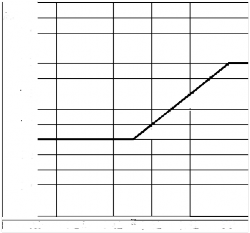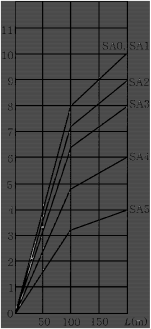

< Previous | Contents | Next >
Section 2 Accelerations
201. General
1. Accelerations in the craft's vertical, transverse and longitudinal axes are obtained by calculating the corresponding linear acceleration and relevant components of angular accelerations as statistically in- dependent variables. The combined acceleration in each direction is as following formula.
: number of independent variables.
2. In Par 1 above, transverse or longitudinal component of the angular acceleration is based on the assumption acts simultaneously in the same direction.
202. Design vertical acceleration
1. Design vertical acceleration at the craft's center of gravity is to be specified by the builder,
and is normally not to be less than that derived from the following formula. However,
is not
to be less than 1.0 for SA0 to SA4 and
is not to be less than 0.5 for
s
m
: gravity acceleration, 9.81 m s .
: acceleration factor (fraction of ) dependent of type and service notation and service area restriction notation given in Table 3.2.1.
= need not be taken greater than 3.0.
2. The design acceleration at different positions along the craft's length is, unless otherwise established, not to be less than :
Pt 3 Hull Structures
Ch 2 Design Loads Pt 3, Ch 2
![]()
: longitudinal distribution factor taken from Fig 3.2.1.
Type | Service area restriction notation | |||||
SA0 | SA1 | SA2 | SA3 | SA4 | SA5 | |
Passenger | 1 | 1 | 1 | 1 | 0.5 | |
Car ferry | 1 | 1 | 1 | 1 | 0.5 | |
Cargo | 4 | 3 | 2 | 1 | 1 | 0.5 |
Patrol | 7 | 5 | 3 | 1 | 1 | 0.5 |
Table 3.2.1 Acceleration Factor ( 
Fig 3.2.1 Longitudinal Distribution Factor for Vertical Design Acceleration
3. The allowable speed corresponding to the design vertical acceleration
may be estimated from
the formulas for the relationship between instantaneous values of (1) When ≥ 3.0 :
and given as
m s
significant wave height (m ).
:
:
deadrise angle at LCG (maximum 30° minimum 10°).
: waterline breadth at /2 (m ), for multihull craft, the total breadth of each monohull (exclusive of tunnels) is to be used.
as given in Par 1.
hull type factor taken from Table 3.2.2.
(2) When <
m s
4. Unless other values are justified according to accepted theoretical calculations, model tests or full scale measurements, the speed reductions implied by Par 3 are to be applied. For SWATH and craft with foil assisted hull, accelerations are normally to be determined in accordance with the di- rect methods above.
5. Relationships between allowable speed and significant wave height are to be stated in the Appendix to Classification Certificate or drawings.
203. Horizontal accelerations
![]()
1. The longitudinal (surge) acceleration is not to be less than that obtained from the following for-
Pt 3 Hull Structures
Ch 2 Design Loads Pt 3, Ch 2
![]()
mula:
: need not be taken greater than 4.0.
: wave coefficient taken from Fig 3.2.2. In cases of craft having unrestricted area restriction notations, the is to be determined by the formula below. Reduction of for restricted service is taken from Table 3.2.3.
service
0.08 : ≤ 100
6 + 0.02 : m
Hull type | k h |
Monohull, Catamaran | 1.0 |
Wave piercer | 0.9 |
SES, ACV | 0.8 |
Foil assisted hull | 0.7 |
SWATH | 0.7 |
Table 3.2.2 Hull Type Factor (
Class notation | Reduction |
SA0 | 0 |
SA1 | |
SA2 | 10 % |
SA3 | 20 % |
SA4 | 40 % |
SA5 | 60 % |
Table 3.2.3 Reduction of

Fig 3.2.2 Wave Coefficient ( )
2. Transverse acceleration is not to be less than in the formula below. However, when above
the axis
of roll, the static component sin
is to be added.
![]()
: roll period, taken from following formula. However need not be taken as greater than 4.0.
Pt 3 Hull Structures
Ch 2 Design Loads Pt 3, Ch 2
![]()
ßᾮ = maximum roll inclination, taken from the following formula:
Ņ
ß ſkᾜE
ᾮ ÜĪÃ
NradǾŃ
ᾜE : maximum wave height in which 70 % of maximum service speed will be maintained, mini- mum 0.6 ǼE.
ᾮᾮ : height above axis of roll, however, axis of roll is to be taken as given for :
- twinhull crafts : ᾮᾮ = waterline
- monohull crafts : ᾮᾮ = 0.5 Á